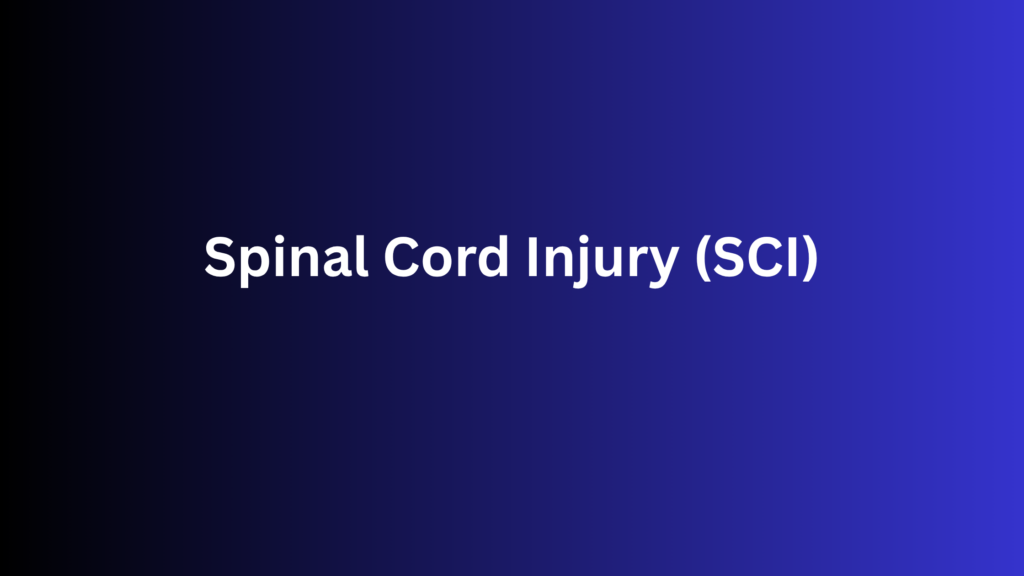
Spinal Cord Injury (SCI) is a serious condition resulting from trauma or disease that disrupts the spinal cord’s function. These injuries are classified based on severity, location, and the extent of neurological impairment. Here’s an overview:
🧠 Classification by Severity
1. Complete SCI
- Definition: Total loss of motor and sensory function below the level of injury.
- Outcome: Permanent paralysis and loss of sensation in affected areas.
2. Incomplete SCI
- Definition: Partial preservation of sensory or motor function below the injury level.
- Outcome: Varied recovery potential, depending on the extent of preserved function.(en.wikipedia.org)
📍 Classification by Injury Level
The location of the injury on the spinal cord determines the type of paralysis:
- Cervical SCI: Affects the neck region; may result in quadriplegia (paralysis of all four limbs).
- Thoracic SCI: Affects the upper and mid-back; may result in paraplegia (paralysis of the lower limbs).
- Lumbar SCI: Affects the lower back; may impact leg function and bladder control.
- Sacral SCI: Affects the tailbone area; may impact bowel, bladder, and sexual function.
🧩 Common Spinal Cord Injury Syndromes
These are specific patterns of neurological deficits resulting from particular types of spinal cord lesions:
1. Central Cord Syndrome
- Cause: Often due to hyperextension injuries in individuals with cervical spondylosis.
- Symptoms: Greater weakness in the upper limbs than in the lower limbs, with variable sensory loss.
- Prognosis: Generally favorable for some degree of neurological and functional recovery. (en.wikipedia.org)
2. Brown-Séquard Syndrome
- Cause: Hemisection of the spinal cord, often due to penetrating trauma.
- Symptoms:
- Ipsilateral (same side) motor paralysis and loss of proprioception.
- Contralateral (opposite side) loss of pain and temperature sensation.
- Prognosis: Varies; some individuals may experience significant recovery. (en.wikipedia.org, pmc.ncbi.nlm.nih.gov)
3. Anterior Cord Syndrome
- Cause: Damage to the anterior spinal artery, leading to ischemia.
- Symptoms:
- Loss of motor function and pain/temperature sensation below the injury level.
- Preserved proprioception and vibratory sense.
- Prognosis: Often poor, with limited recovery. (msdmanuals.com, en.wikipedia.org)
4. Posterior Cord Syndrome
- Cause: Infarction of the posterior spinal artery.
- Symptoms:
- Loss of proprioception and vibratory sense.
- Preserved motor function and pain/temperature sensation.
- Prognosis: Generally poor, with minimal recovery.
5. Conus Medullaris Syndrome
- Cause: Injury to the conus medullaris, the tapered end of the spinal cord.
- Symptoms:
- Lower extremity weakness.
- Saddle anesthesia (numbness in the buttocks, perineum, and inner thighs).
- Bowel and bladder dysfunction.
- Prognosis: Varies; some individuals may experience significant recovery. (msdmanuals.com, en.wikipedia.org, en.wikipedia.org)
6. Cauda Equina Syndrome
- Cause: Compression or damage to the cauda equina, a bundle of spinal nerves below the conus medullaris.
- Symptoms:
- Severe lower back pain.
- Loss of sensation in the “saddle” area.
- Bowel and bladder dysfunction.
- Sexual dysfunction.
- Prognosis: Requires emergency treatment; outcomes depend on the timeliness of intervention.
🧬 Classification by Mechanism
Spinal cord injuries can also be classified based on the mechanism of injury:
- Traumatic: Caused by external forces such as falls, motor vehicle accidents, or sports injuries.
- Non-traumatic: Result from internal factors like infections, tumors, or degenerative diseases.
🧪 Diagnosis and Imaging
Diagnosis typically involves:
- Clinical Evaluation: Assessment of neurological function.
- Imaging Studies:
- MRI: Provides detailed images of the spinal cord and surrounding structures.
- CT Scan: Useful for detecting bone fractures or dislocations.
🧑⚕️ Treatment and Rehabilitation
Management of SCI includes:
- Emergency Care: Stabilization of the spine and prevention of further injury.
- Surgical Intervention: To decompress the spinal cord or stabilize the spine.
- Rehabilitation:
- Physical therapy to improve mobility and strength.
- Occupational therapy to assist with daily activities.
- Psychological support to address emotional and mental health needs.
